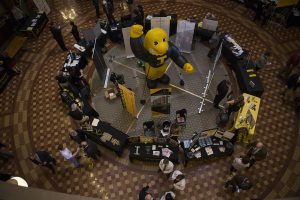Iowa regents delay tuition discussion as state lawmakers work on budget
While Iowa lawmakers hammer out the fiscal 2020 state budget, the state Board of Regents will likely delay discussing tuition rates for the 2019-20 academic year.
Regent President Michael Richards listens to a presentation during a state Board of Regents meeting in the IMU Main Lounge on Thursday, Sept. 7, 2017.
April 9, 2019
The state Board of Regents announced its members will likely hold off on the tuition discussion and will not read tuition rates during their April meeting, as the state Legislature has not finalized fiscal 2020 funding for the regent universities.
According to a Tuesday news release from the regents, there is not enough information on the state-appropriations amount at this time to conduct a reading of tuition rates.
Tuition could be added to the regents’ meeting agenda for April 18 if more information becomes available. The item will be added no later than 24 hours before the meeting if more information is acquired in compliance with state law.
RELATED: UI, ISU students likely to see 3 percent tuition hikes for five years, Iowa regents decide
If tuition is not added to the agenda, there will be a special meeting held in either late April or early May for a reading. The regents last delayed a first reading of tuition rates and held a special meeting to discuss academic year 2017-18 tuition rates on May 8, 2017.
Final approval of 2019-20 academic year tuition rates remains set for the June 4-6 regents meeting at this time.
“We need more information about the state budget and what the Regents appropriation will be to determine our tuition rates,” Regent President Mike Richards said in the release. “We will move forward with setting tuition rates once we have a better idea of what funds the state will provide to us.”
The Iowa House passed a $961 million education-appropriations bill on April 4, which included a $15.9 million boost for the regent universities to split between the three. This increase falls short of the regents’ request of $18 million in state support passed in September 2018, which Iowa Gov. Kim Reynolds suggested fully funding in her state-budget proposal released in January.
RELATED: Iowa regents plan to take ‘holistic approach’ to funding universities
The regents approved the multiyear tuition model in November 2018, presenting a timeline for tuition increases for in-state students for the next five years. The tuition model specifies that tuition will increase by 3 percent if state-appropriations requests are funded. If the request is not funded, the tuition will increase by 3 percent plus Higher Education Price Index.
Should state lawmakers pass the current House proposal that doesn’t fully fund the regents’ request for state support, University of Iowa and Iowa State University tuition-rate hikes for resident undergraduates would fall within the 3 percent to 5 percent range.
“… We think everyone can plan on a 3 percent increase and they can follow along how the funding request goes in the Legislature, and then what we’re [seeing] is the [index] is about 2 percent this year,” Richards said at the November meeting. He noted the index could be higher or lower.
RELATED: Iowa regents’ multiyear tuition model ‘better for students,’ UI president says
UI President Bruce Harreld discussed the multiyear tuition model in a December 2018 interview with The Daily Iowan, and he supported the predictability he believes it creates for in-state students.With UI resident tuition being lower than other schools in the peer group, he said it was a good deal, but advocated for continued tuition increases to get the UI’s rates to the average of the peer group.
“… I don’t think our competitive institutions, our peer institutions, are going to keep their tuitions flat. Because there’s still inflation.”
Ultimately, Harreld said he thought the tuition model makes funding more predictable for students.
“I think you can expect to be in this 3 to 6 percent range every year therefore, it’s going to cost more. Not good, but those are the facts,” Harreld said.






